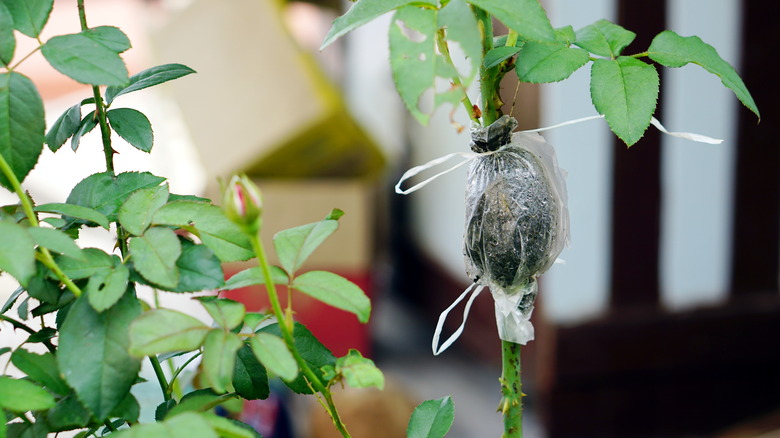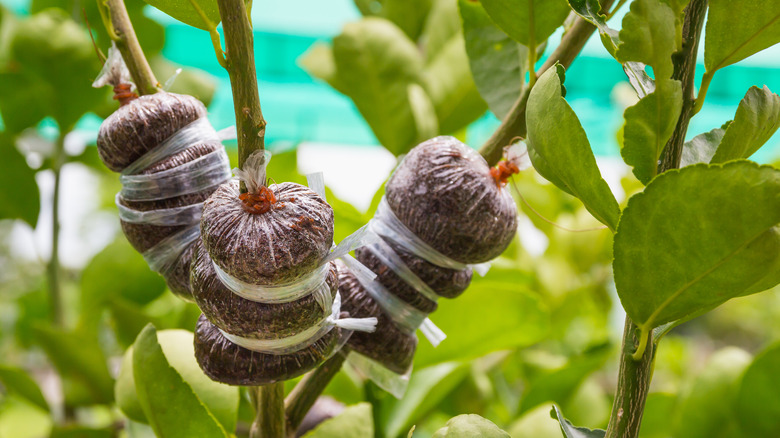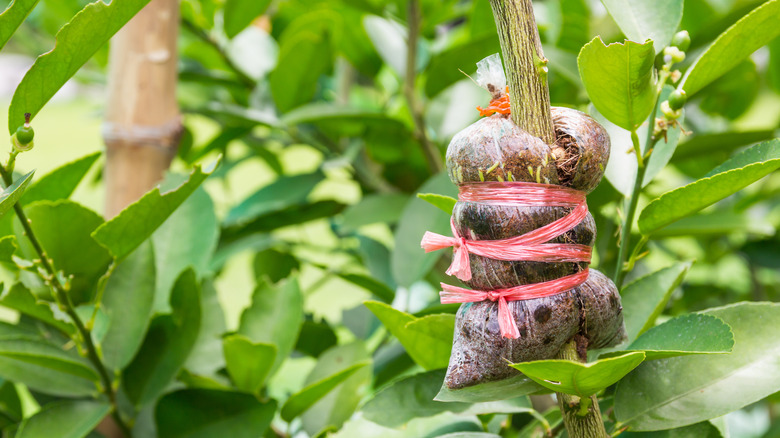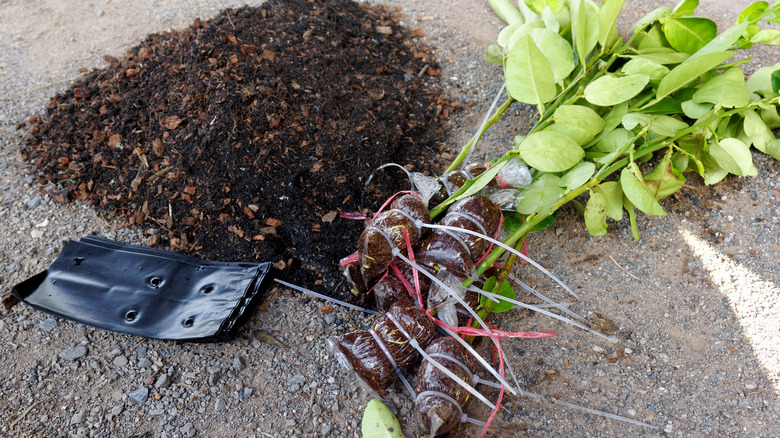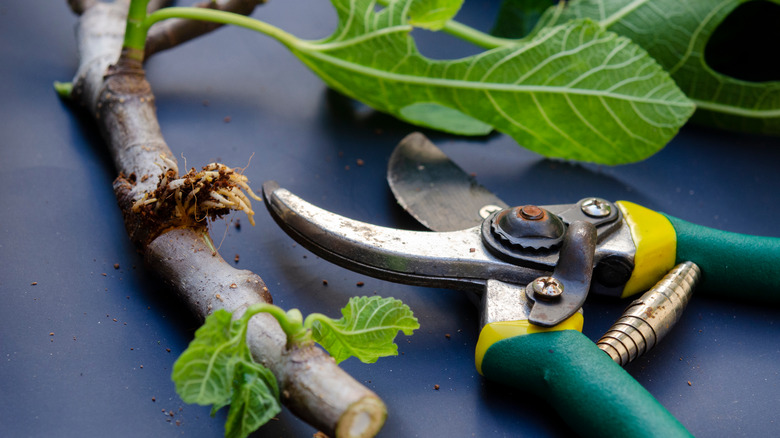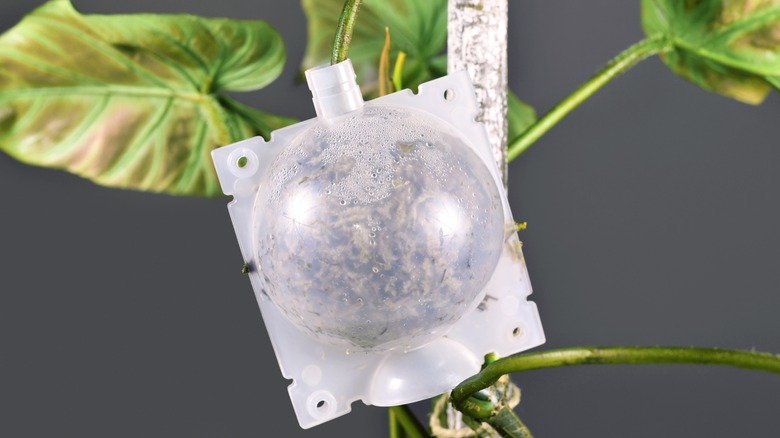What To Know About Air Layering Your Indoor Plants
Air layering is nothing new in the gardening world; in truth, it is an ancient Chinese propagation technique that is quite popular among gardeners and seasoned plant parents. Regardless of your experience with plants, you will be happy to discover that this propagation method is relatively easy to implement. You don't necessarily need a particular horticultural degree or several years of experience to pull it off. At its core, air layering attempts to induce the growth of roots from a stem that is still attached to the mother plant.
Compared to the traditional propagation method, air layering is a simpler and easier way to have new plants, mentions WhyFarmIt. When done correctly, you can quickly get new healthy plants within a few weeks instead of months if you propagate the conventional way. So if your indoor plant is growing taller than you want, air layering gives you the perfect opportunity of propagating and cutting the top part without necessarily killing the entire plant. Here is a detailed breakdown of everything you need about air layering indoor plants. Tag along!
What exactly is air layering?
Like the conventional method of taking cuttings, air layering involves injuring the plant by making a small cut while still attached to the mother plant. However, you only remove the section when root development makes it possible to propagate. According to IOWA State University Extension and Outreach, the wounded area on the stem stops carbohydrates and other nutrients from traveling to the roots. Consequently, the accumulation of nutrients at the injured or wounded section promotes the growth of adventitious roots.
Usually, this cut section is wrapped around with damp soil or sphagnum moss to promote better root growth. When the root development is enough, you can go ahead and cut the step right below the root development and transplant the new plant. This way, you can have a completely healthy new plant without compromising the mother plant. Usually, the new plant often has similar characteristics to the mother plant.
Benefits of air layering
One of the most significant benefits of air-layering plants is their ability to propagate, even for new plant parents. The simplicity of the technique also contributes immensely to the success rate of the propagation. Unlike regular propagation, where the plant can easily dry out after separation from the mother plant, air layering allows the respective section to receive the necessary moisture from the main plant, via Clemson University Cooperative Extension Service. Another essential benefit of air layering is that you can easily get larger and more mature plants without waiting for months or even years.
Also, matured plants are generally easier to care for than tending to weak seedlings or cuttings that show signs of withering. It is also worth mentioning that the primary purpose of cutting plant sections for propagation is to encourage root development. However, the sad reality is that this doesn't always happen. On the other hand, air layering is a more reliable way of encouraging root growth without damaging the actual plant. Remember, you only sever the section once there is proper root development.
What is the best time for air layering?
The beauty of this ancient Chinese technique is that you can use it any time of the year. It often happens in the wild whenever a stem finds its way to the ground and is covered with soil. When it comes to indoor plants, however, they need all the help they can get. As such, you need to be quite deliberate with the timing whenever you want to air-layer your indoor plants.
According to Texas A&M AgriLife Extension, the best time for air layering is when the plant is actively growing during spring. This is especially true when propagating from the shoots of the previous season. Air layering during spring is more effortless because the barks are not hard enough, making them easier to remove. However, if you are late to the party, you can air-layer your plants during summer on the shoots that have developed during the growing season.
Is air layering possible for all plants?
The good news is that air layering can easily propagate most indoor and outdoor plants. However, this technique is more beneficial to those plants that find it hard to develop roots on their own after separation from the mother plant. As far as indoor plants are concerned, air layering can be done on overgrown tropical indoor plants, for instance, the rubber plant or croton, just to mention a few.
Other than that, air layering is possible on woody outdoor plants like camellia and magnolia, among several others, via the North Carolina State University Extension. As mentioned earlier, one of the benefits of air layering is getting a new plant with the same characteristics as the mother plant. With this in mind, it can be tempting to propagate every fruit tree with desirable characteristics via air layering. While it can work for regular fruit trees, air layering a grafted tree might not guarantee the best results.
Air layering follow-up care
Propagation via air layering is not complex; however, after making the cut and wrapping the section with moist soil or sphagnum moss, you need to provide extra care to ensure root development. The most crucial aftercare practice is making sure the moss or soil remains wet and adding just enough water whenever the medium appears dry. This is especially true if you didn't wrap the moss tight enough to prevent moisture from escaping. Be sure to provide the plant enough time to develop new roots.
According to South Dakota State University Extension, root development should take 6 to 10 weeks; until then, just sit on your hands and let the process take its course. Once you notice enough healthy roots about 2 inches long formed inside the wrap, it is time to cut and transplant the new plant. The right place to cut is right below the roots, remove the wrap and plant it in a different pot with the moss in the area. Limit sun exposure in the early stages — it is ideal to gradually introduce your new plant to the sun over time.
